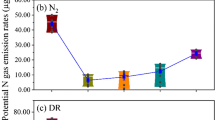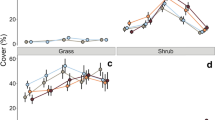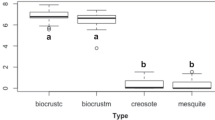Abstract
Human activities are altering biodiversity and the nitrogen (N) cycle, affecting terrestrial carbon (C) cycling globally. Only a few specialized bacteria carry out nitrification—the transformation of ammonium (NH +4 ) to nitrate (NO −3 ), in terrestrial ecosystems, which determines the form and mobility of inorganic N in soils. However, the control of nitrification on C cycling in natural ecosystems is poorly understood. In an ecosystem experiment in the Patagonian steppe, we inhibited autotrophic nitrification and measured its effects on C and N cycling. Decreased net nitrification increased total mineral N and NH +4 and reduced NO −3 in the soil. Plant cover (P < 0.05) and decomposition (P < 0.0001) decreased with inhibition of nitrification, in spite of increases in NH +4 availability. There were significant changes in the natural abundance of δ15N in the dominant vegetation when nitrification was inhibited suggesting that a switch occurred in the form of N (from NO −3 to NH +4 ) taken up by plants. Results from a controlled-condition experiment supported the field results by showing that the dominant plant species of the Patagonian steppe have a marked preference for nitrate. Our results indicate that nitrifying bacteria exert a major control on ecosystem functioning, and that the inhibition of nitrification results in significant alteration of the C cycle. The interactions between the C and N cycles suggest that rates of C cycling are affected not just by the amount of available N, but also by the relative availability for plant uptake of NH +4 and NO −3 .





Similar content being viewed by others
References
Aber JD, Magill A, Boone RD. 1993. Plant and soil responses to chronic nitrogen additions at the Harvard forest. Ecol Appl 3:156–66
Aerts R, Berendse F. 1988. The effect of increased nutrient availability on vegetation dynamics in wet heathlands. Vegetatio 76:63–9
Ågren G, Bosatta E, Magill AH. 2001. Combining theory and experiment to understand effects of inorganic nitrogen on litter decomposition. Oecologia 128:94–8
Austin AT, Sala OE. 2002. Carbon and nitrogen dynamics across a natural gradient of precipitation in Patagonia, Argentina. J Veg Sci 13:351–60
Carreiro M, Sinsabaugh RL, Repert DA, Parkhurst DF. 2000. Microbial enzyme shifts explain litter decay responses to simulated nitrogen deposition. Ecology 81:2359–65
Chapin FS III, Zavaleta ES, Eviner VT, Naylor RL, Vitousek PM, Reynolds HL, Hooper DU, et al. 2000. Consequences of changing biodiversity. Nature 405:234–42
Crawford DM, Chalk PM. 1992. Mineralization and immobilization of soil and fertilizer nitrogen with nitrification inhibitors and solvents. Soil Biol Biochem 24:559–68
Falkengren-Grerup U, Michelsen A, Olsson MO, Sleep D, Quarmby C. 2004. Plant nitrate use in deciduous woodland: the relationship between leaf N, 15N natural abundance of forbs and soil N mineralisation. Soil Biol Biochem 36:1885–91
Fernández RJ, Sala OE, Golluscio RA. 1991. Woody and herbaceous aboveground production of a Patagonian steppe. J Range Manage 44:434–7
Galloway JN, Cowling EB. 2002. Reactive nitrogen and the world: 200 years of change. Ambio 31:64–71
Gill RA, Polley HW, Johnson HB, Anderson LJ, Maherali H, Jackson RB. 2002. Nonlinear grassland response to past and future atmospheric CO2. Nature 417:279–82
Golluscio RA, Sala OE. 1993. Plant functional types and ecological strategies in Patagonian forbs. J Veg Sci 4:839–46
Goring CAI. 1962. Control of nitrification by 2-chloro-6-(trichloromethyl) pyridine. Soil Sci 93:211–8
Greig-Smith P. 1983. Quantitative plant ecology. Oxford (UK): Blackwell Scientific. 359 p
Gundersen P, Emmett BA, Kjonaas OJ, Koopmans CJ, Tietema A. 1998. Impact of nitrogen deposition on nitrogen cycling in forests: a synthesis of NITREX data. For Ecol Manage 101:37–55
Handley LL, Raven JA. 1992. The use of natural abundance of nitrogen isotopes in plant physiology and ecology. Plant Cell Environ 15:965–85
Handley LL, Austin AT, Robinson D, Scrimegour CM, Raven JA, Heaton THE, Schmidt S, et al. 1999. The 15-N natural abundance (δ15N) of ecosystem samples reflects measures of water availability. Aust J Plant Physiol 26:185–199
Hart SC, Nason GE, Myrold DD, Perry DA. 1994. Dynamics of gross nitrogen transformations in an old-growth forest: the carbon connection. Ecology 75:880–91
Haynes RJ, Goh KM. 1978. Ammonium and nitrate nutrition of plants. Biol Rev 53:465–510
Hobbie SE. 2000. Interactions between litter lignin and soil nitrogen availability during leaf litter decomposition in a Hawaiian montane forest. Ecosystems 3:484–94
Hu S, Chapin FS III, Firestone MK, Field CB, Chiariello NR. 2001. Nitrogen limitation of microbial decomposition in a grassland under elevated CO2. Nature 409:188–191
Jackson LE, Schimel JP, Firestone MK. 1989. Short-term partitioning of ammonium and nitrate between plants and microbes in an annual grassland. Soil Biol Biochem 21:409–15
Jobbágy EG, Sala OE. 2000. Controls on grass and shrub aboveground production in the Patagonian steppe. Ecol Appl 10:541–9
Kholdebarin B, Mozafar A, Frossard E. 1998. Differential inhibition of nitrification by three metabolic inhibitors. J Plant Nutr 21:929–36
Kronzucker HJ, Glass ADM, Siddiqi MY. 1999. Inhibition of nitrate uptake by ammonium in barley: analysis of component fluxes. Plant Physiol 120:283–91
Lambers H, Chapin FS III, Pons TL. 1998. Plant physiological ecology. New York: Springer-Verlag
Leininger S, Urich T, Schloter M, Schwark L, Qi J, Nicol GW, Prosser JI, Schuster SC, Schleper C. 2006. Archaea perdominate among ammonia-oxidizing prokaryotes in soils. Nature 442:806–809
López NI, Austin AT, Sala OE, Méndez B. 2003. Controls on nitrification in a water-limited ecosystem: experimental inhibition of ammonia-oxidizing bacteria in the Patagonian steppe. Soil Biol Biochem 35:1609–13
Magill AH, Aber JD. 1998. Long-term effects of experimental nitrogen additions on foliar litter decay and humus formation in forest ecosystems. Plant Soil 203:301–11
Mariotti A, Pierre D, Vedy JC, Bruckert S, Guillemot J. 1981. Experimental determinations of nitrogen kinetic isotope fractionations: some principles. Illustration for the denitrification and nitrification process. Plant Soil 62:413–30
McCarty GW. 1999. Modes of action of nitrification inhibitors. Biol Fertil Soil 29:1–9
McKane RB, Johnson LC, Shaver GR, Nadelhoffer KJ, Rastetter EB, Fry B, Giblin AE, et al. 2002. Resource-based niches provide a basis for plant species diversity and dominance in arctic tundra. Nature 415:68–71
Nadelhoffer KJ, Emmett BA, Gundersen P, Kjonaas OJ, Koopmans CJ, Schleppi P, Tietema A, et al. 1999. Nitrogen deposition makes a minor contribution to carbon sequestration in temperate forests. Nature 398:145–8
Neff JC, Townsend AR, Gleixner G, Lehman SJ, Turnbull J, Bowman WD. 2002. Variable effects of nitrogen additions on the stability and turnover of soil carbon. Nature 419:915–7
Nordin A, Högberg P, Näsholm T. 2001. Soil nitrogen form and plant nitrogen uptake along a boreal forest productivity gradient. Oecologia 129:125–32
Paul EA, Clark FE. 1996. Soil microbiology and biochemistry. San Diego (CA): Academic Press. 340 p
Reich PB, Knops J, Tilman D, Craine J, Ellsworth D, Tjoelker M, Lee T, et al. 2001. Plant diversity enhances ecosystem responses to elevated CO2 and nitrogen deposition. Nature 410:809–11
Robertson GP, Paul EA. 2000. Decomposition and soil organic matter dynamics. In: Sala OE, Jackson RB, Mooney HA, Howarth RW, editors. Methods in ecosystem science. New York: Springer. p 104–16
Sahrawat KL. 1989. Effects of nitrification inhibitors on nitrogen transformations, other than nitrification, in soils. Adv Agron 42:279–309
Sala OE, Golluscio RA, Lauenroth WK, Soriano A. 1989. Resource partitioning between shrubs and grasses in the Patagonian steppe. Oecologia 81:501–5
Sala OE, Chapin FS III, Armesto JJ, Berlow E, Bloomfield J, Dirzo R, Huber-Sanwald E, et al. 2000. Global biodiversity scenarios for the year 2100. Science 287:1770–4
Schlesinger WH. 1997. Biogeochemistry: an analysis of global change. San Diego (CA): Academic Press. 443 p
Schlesinger WH, Lichter J. 2001. Limited carbon storage in soil and litter of experimental forest plots under increased atmospheric CO2. Nature 411:466–9
Sokal RR, Rohlf FJ. 1995. Biometry. New York: WH Freeman. 887 p
Soriano A, Sala OE. 1983. Ecological strategies in a Patagonian arid steppe. Vegetatio 56:9–15
Soriano A, Sala OE, Perelman SB. 1994. Patch structure and dynamics in a Patagonian arid steppe. Vegetatio 111:127–35
Stark JM, Hart SC. 1997. High rates of nitrification and nitrate turnover in undisturbed conifer forests. Nature 385:61–4
Tilman D. 1993. Species richness of experimental productivity gradients: how important is colonization limitation? Ecology 74:2179–91
Valle HFD. 1998. Patagonian soils: a regional synthesis. Ecol Aust 8:103–24
Van Soest PJ. 1963. Use of detergents in analysis of fibrous feeds. II. A rapid method for the determination of fiber and lignin. Assoc Off Analy Chem 46:829–35
Vitousek PM, Aber JD, Howarth RW, Likens GE, Matson PA, Schindler DW, Schlesinger WH, et al. 1997a. Human alteration of the global nitrogen cycle: sources and consequences. Ecol Appl 7:737–50
Vitousek PM, Mooney HA, Lubchenco J, Melillo JM. 1997b. Human domination of Earth’s ecosystems. Science 277:494–9
Wedin DA, Tilman D. 1996. Influence of nitrogen loading and species composition on the carbon balance of grasslands. Science 274:1720–3
Acknowledgements
The research was supported by a grant from the Inter-American Institute for Global Change Research (CRN-012), the Fondo para la Investigación Científica y Tecnológica (FONCyT), and the University of Buenos Aires; additional institutional support was provided by IFEVA. A.T.A. was supported by a National Science Foundation International Research Fellowship and a grant from Fundación Antorchas of Argentina. We thank Jerry Huffman of DowElanco for his expertise and the donation of N-serve 24E for use in our experiment. J. Vrsalovic, L. Vivanco, P. Flombaum, N. Sala, J. Rotundo, R. Pera, P. Roset, and S. Veron provided field assistance, and M. Tagliazucchi, A. Sala, I. Montoya, and W. Cook provided laboratory assistance. L. Gherardi assisted with the greenhouse experiment. T. Loynachan, D. Mengel, G. Malzer, A. Mosier and P. Vitousek supplied us with information about nitrification inhibitors. We are especially grateful to R. Sanchez, J. Stark, and W. Schlesinger for their comments on the experiment.
Author information
Authors and Affiliations
Corresponding author
Rights and permissions
About this article
Cite this article
Austin, A.T., Sala, O.E. & Jackson, R.B. Inhibition of Nitrification Alters Carbon Turnover in the Patagonian Steppe. Ecosystems 9, 1257–1265 (2006). https://doi.org/10.1007/s10021-005-0039-0
Received:
Accepted:
Published:
Issue Date:
DOI: https://doi.org/10.1007/s10021-005-0039-0




